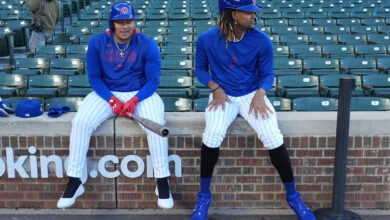
Cubs Prospect Profile: Tyson Miller Off to Decent Start in 2017
When I first saw Tyson Miller pitch for the Eugene Emeralds in 2016, I was not that impressed. But I took his performance with a grain of salt considering he was shut down for a month after the end of his junior season at California Baptist. In both games I saw, he was throwing his fastball 89-91 and topping out at 93. It has to be hard to play a full season, take a month off, and then restart.
This year, however, Miller could be the breakout pitcher of the year in the Cubs organization.
Current Info
Starting Pitcher
6-5, 200 pounds
Throws right
21 years old
Strengths
Throws in the mid-90’s
Ascending
Projectable frame
Plus slider
Excellent strikeout rate in Cape Cod League with an
Areas of Concern
Changeup
Played against limited competition at Division II
What others say
Scout.com said the following about Miller in 2016.
Possibly the best arm out of NCAA DII baseball, […] His fastball has good running movement in the low 90’s, touching 95, but batters have been very aggressive against it. He has a stellar changeup, but that seems to be his only off-speed offering as his slider flattens through the ‘zone. He has some stiffness in his delivery, but shows a loose arm, and is projectable.
 At Eugene
At Eugene
Miller threw 22.2 IP with a 3.86 ERA and was part of the championship team, but his season was up-and-down. He did not allow run in his first two starts and was roughed up in his next three before he settled down. It should be noted that those starts were generally limited to 3 innings or so. In the postseason, he made one start and gave up 4 runs in 3.2 IP.
South Bend
Miller is a very different pitcher this year. His velocity has been sitting between 93 and 96 most nights and he is locating his pitches with more consistency. There doesn’t seem to be much shaking off of the catcher. He looks extremely athletic and fluid on the mound and gets deep on his release, which might provide some deception for him.
The biggest change I see is in the sharpness of his breaking ball. While some people call it a curve, others say it’s a slider. At times, I think it has some cutting action to it. What really amazes me is that he throws the pitch high in the zone for strikes, too.
Miller took the mound on April 17 against Great Lakes for his third start of the year and got through the first two innings relatively fine. He was leaving pitches up in the zone and getting away with it. That wouldn’t last for too long, though, as he gave up four runs in the top of the 4th, three of them on a home run. The same was true for his most recent start against Dayton, in which he allowed six earned on as many hits over only 4.2 innings.
While his pitching may not have been the best those last times out, I have been impressed with how he has worked out of jams. He now has an ERA of 4.66 and has struck out 19 in 19.1 innings at South Bend. These are the kinds of ups and downs Miller is supposed to experience at low-A. He need to continue to develop his body and mind and be able throw three pitches with excellent command.
What I would like to see in 2017
Going forward, Miller’s curveball needs some location adjustment. He tended to throw it very high in the zone from what I saw. On the other hand, if he cannot command his fastball, the curveball doesn’t really matter.
His fastball got tatered because he could not command it down in the zone. It came up and the ball went out. Of course, that was just his third start and the first time that he gave up any runs. I still think working on his fastball command is job one. The other two pitches will fall in line afterwards.

